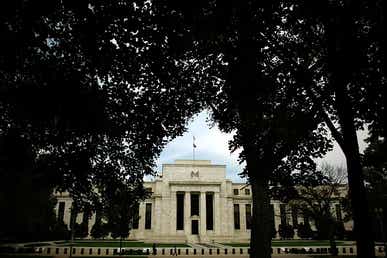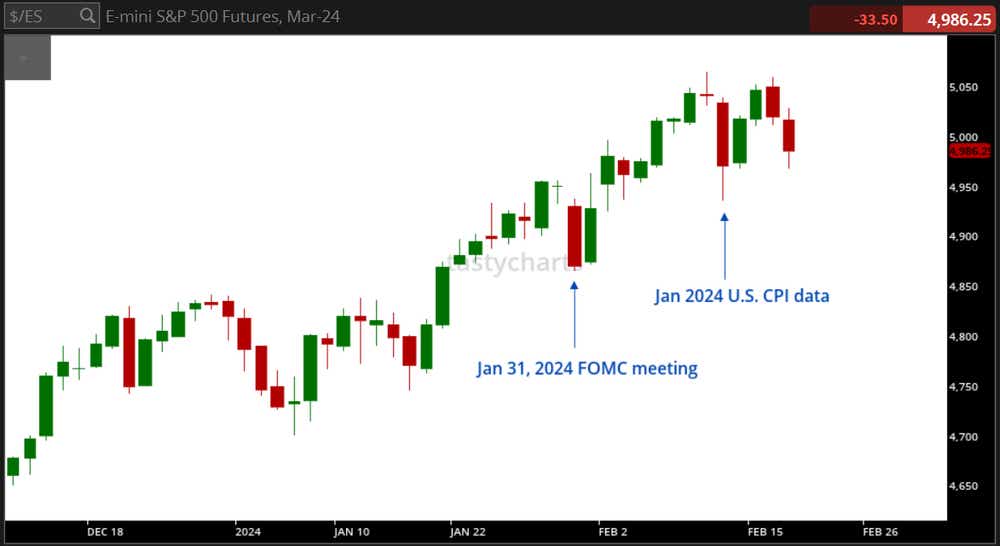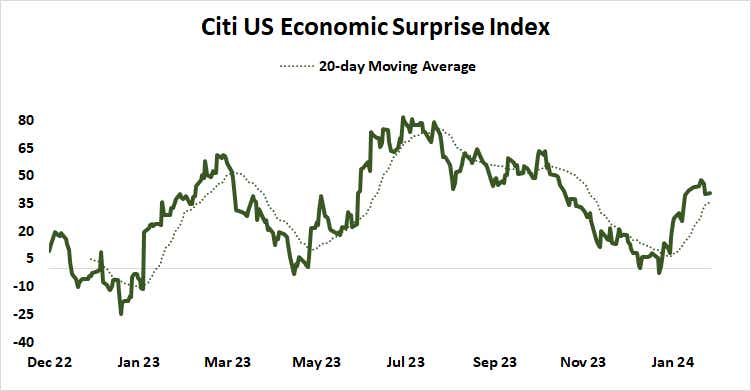FOMC Minutes Preview: Do Stock Markets Need to Worry About Rates?

FOMC Minutes Preview: Do Stock Markets Need to Worry About Rates?
By:Ilya Spivak
Stock markets may come under pressure if minutes from January’s Federal Reserve policy meeting hint that interest rate cuts this year are not as assured as investors hope.
- Stocks are struggling in February after hot CPI data and hawkish Federal Reserve rhetoric.
- The January Federal Open Market Committee meeting minutes are in focus as rate-cut expectations cool.
- Wall Street is at risk if the interest rate easing autopilot seems less likely than before.
Stock markets shuddered in the wake of January’s Federal Reserve monetary policy meeting. Signaling they are reticent about declaring victory over inflation, central bank officials pushed back on runaway interest rate cut expectations that fueled a blistering Wall Street rally in November and December 2023.
The selloff would not prove to be lasting. Buyers reclaimed the upper hand within just 24 hours despite the S&P 500 suffering its worst one-day loss in four months, pushing the bellwether equity index up over 4% to hit a record high over the subsequent week and a half.
Do stocks care about Fed rate cut plans?
Perhaps markets concluded that Fed Chair Jerome Powell and company would change their tune as new inflation data continued to show progress. As it happens, the markets were forced to rethink what’s next. January’s consumer price index (CPI) data showed core price growth unexpectedly held at 3.9%, disappointing bets on a decline to 3.7%.

That sent another chill down investors’ spines. The S&P 500 dropped 1.39%, erasing half of the recovery carved out after the Fed’s policy meeting. This time, attempts at rekindling the rally have met with stiffer resistance. Seesawing price action over the following four trading days has brought stocks back to where they landed in the CPI data’s wake.
The spotlight now turns to minutes from that fateful meeting of the central bank’s policy-steering Federal Open Market Committee (FOMC). The release is an editorial description of proceedings instead of a strict stenographic transcript. That means the Fed can use it to steer investors’ expectations despite its being seemingly backward-looking.
FOMC meeting minutes: old news is new again
With that in mind, traders will keenly parse the document for clues. Market pricing implied in Fed Funds futures reveals that rate cut expectations almost halved in a mere month. Traders now bet on 85 basis points (bps) in easing this year, down from 158 bps in mid-January and 137 bps before that month’s FOMC meeting.

This brings the markets into broad alignment with what the Fed officials signaled with their latest update of official rate projections, issued in December. They envisioned the Fed Funds rate declining from 5.4% in 2023 to 4.6% this year, implying 80 bps in rate cuts.
The U.S. economy has turned out stronger than expected. Analytics from Citigroup show data outcomes have increasingly outperformed relative to baseline forecasts over the past month. The Fed’s resistance to commit to stimulus over the same period makes sense against this backdrop.
Should stock markets be worried?
January’s FOMC statement argued that rate cuts are not on the menu “until [the FOMC] has gained greater confidence that inflation is moving sustainably toward 2%.” It went on to warn that officials are “prepared to adjust the stance of monetary policy as appropriate” if reaching its goals is threatened, implying that cuts are not guaranteed.
This probably puts the question of symmetry front and center. If Fed officials truly seem prepared to jettison rate cuts altogether and even consider the unlikely step of tightening further as the buoyant economy stymies disinflation, stock markets may be in for a rude awakening.

Ilya Spivak, tastylive head of global macro, has 15 years of experience in trading strategy, and he specializes in identifying thematic moves in currencies, commodities, interest rates and equities. He hosts Macro Money and co-hosts Overtime, Monday-Thursday. @Ilyaspivak
For live daily programming, market news and commentary, visit tastylive or the YouTube channels tastylive (for options traders), and tastyliveTrending for stocks, futures, forex & macro.
Trade with a better broker, open a tastytrade account today. tastylive, Inc. and tastytrade, Inc. are separate but affiliated companies.
Options involve risk and are not suitable for all investors. Please read Characteristics and Risks of Standardized Options before deciding to invest in options.